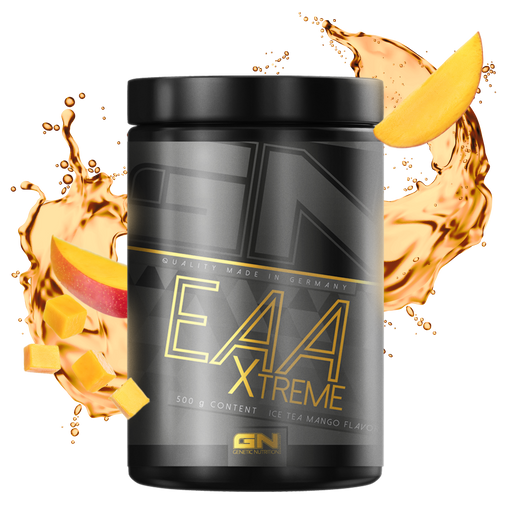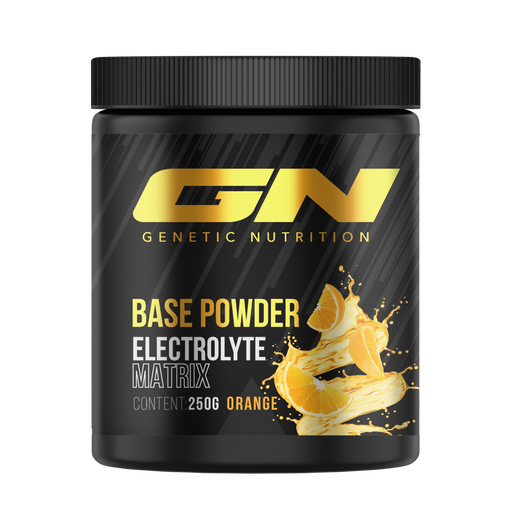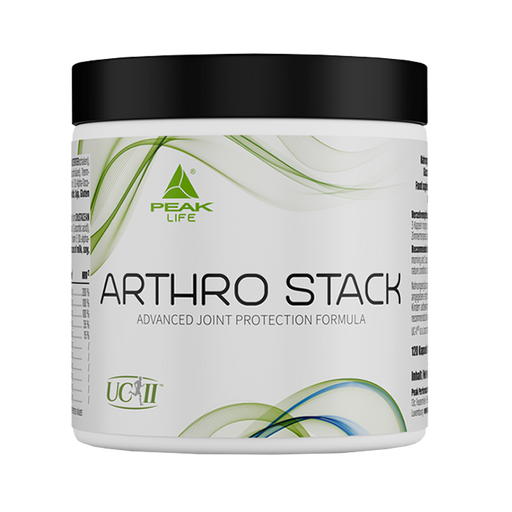Potassium
Filters
-
 Save 0%
Save %
Original price €29,90 - Original price €29,90Original price €29,90€29,90€29,90 - €29,90Current price €29,90| /
Save 0%
Save %
Original price €29,90 - Original price €29,90Original price €29,90€29,90€29,90 - €29,90Current price €29,90| /EAA Xtreme · 500g
GN Laboratories114 reviewsAn anabolic and anti-catabolic powerhouse for use before, during and after training or at any other time of day when you need a boost of anabolic a...
View full detailsOriginal price €29,90 - Original price €29,90Original price €29,90€29,90€29,90 - €29,90Current price €29,90| /Save 0% Save % -
 Save 0%
Save %
Original price €16,90 - Original price €16,90Original price €16,90€16,90€16,90 - €16,90Current price €16,90| /
Save 0%
Save %
Original price €16,90 - Original price €16,90Original price €16,90€16,90€16,90 - €16,90Current price €16,90| /Base Powder · 250g
GN Laboratories24 reviewsThere is an acid-base balance in the human body, and if this gets out of balance, it can lead to a whole range of symptoms that impair well-being. ...
View full detailsOriginal price €16,90 - Original price €16,90Original price €16,90€16,90€16,90 - €16,90Current price €16,90| /Save 0% Save % -
 Save 0%
Save %
Original price €29,90 - Original price €29,90Original price €29,90€29,90€29,90 - €29,90Current price €29,90| /
Save 0%
Save %
Original price €29,90 - Original price €29,90Original price €29,90€29,90€29,90 - €29,90Current price €29,90| /Bulletproof EAA's V2 · 500g
Big Zone13 reviewsFull spectrum of EAAs including increased BCAA content 3 grams of leucine per serving Colorant free Made in Germany Electrolyte Matrix Adaptogenic...
View full detailsOriginal price €29,90 - Original price €29,90Original price €29,90€29,90€29,90 - €29,90Current price €29,90| /Save 0% Save % -
 Save 11%
Save %
Original price €24,90Original price €24,90 - Original price €24,90Original price €24,90Current price €22,16€22,16 - €22,16Current price €22,16| /
Save 11%
Save %
Original price €24,90Original price €24,90 - Original price €24,90Original price €24,90Current price €22,16€22,16 - €22,16Current price €22,16| /Arthro Stack · 120 capsules
PEAK1 reviewFor joints, cartilage, tendons and ligaments - Now with an improved formula New with collagen type II (UC-II®) 1200 mg glucosamine sulphate, 500 m...
View full detailsOriginal price €24,90Original price €24,90 - Original price €24,90Original price €24,90Current price €22,16€22,16 - €22,16Current price €22,16| /Save 11% Save %
Potassium with the chemical symbol K is an alkali metal with the atomic number 19. In its pure form, it is shiny silver-white and almost waxy. In the air it reacts very quickly to form potassium oxide and over a longer period of time with the carbon dioxide in the air to form potassium carbonate, which is also known as potash (K2CO3). It is the 7th most common element in the earth's crust. It does not occur in nature in elemental form. The most important potassium compounds are potassium salts (e.g. KCl), potassium feldspar or potassium mica. In the course of the earth's history, some of the potassium salt deposits were washed out and into the sea, hence the proportion of potassium salts in seawater. Potassium only plays a subordinate role in technology. Potassium compounds are used for soap production, in the glass and ceramics industry or as a desiccant in laboratories or in oxygen devices. The element potassium was discovered and described in London in 1807 by the English chemist Sir Humphrey Davy (1778-1829) together with sodium. Its name is derived from the Arabic word Kalja = ash. In medicine, potassium permanganate (KMnO4) is of some interest as a special potassium compound. This substance is used for external application as an antiseptic in a concentration of 0.01-0.05% to disinfect injuries due to its very strong oxidative effect, although it is increasingly being replaced by other active ingredients. However, it is still used more frequently as a disinfectant additive in rinses and baths.
Functions in the body
Potassium is an important electrolyte in the body and is therefore often routinely measured in blood tests. The potassium concentration in the serum must be between 3.5 and 5.5 mmol/l. Potassium is mainly present inside the cell, around 98% of it. Potassium is also involved in the production of energy and in the water-electrolyte balance. Together with other electrolytes (charged particles) and molecules, it plays a significant role in maintaining the osmotic pressure in the cells. Among other things, potassium is involved in the activation of some enzymes, in the biosynthesis of protein, as well as in carbohydrate metabolism and thus in energy production. Together with sodium, calcium and chlorine, potassium has an effect on heart muscle activity and is responsible for the excitability of muscle and nerve cells. This is achieved by creating an electrical potential difference between the inside and outside of the cell. The inside of a heart cell is charged to approx. -70 mV and the outside of a muscle and nerve cell to approx. -90 mV. For those who are particularly interested, this process can be explained as follows: The cells of the heart, like skeletal muscle cells, have an electrical voltage between the inside and outside of the cell. In skeletal muscle, the voltage between the inside and outside of the cell at rest is approx. -90 mV (mV = millivolts), in the heart approx. -70 mV, whereby the inside of the cell is negatively charged compared to the outside. The main reason for this voltage is the property of the cell membrane to have different permeabilities for the various ions present in the body. This permeability of the membrane can be changed by means of chemical, mechanical or electrical stimuli. A skeletal muscle maintains its electrical voltage permanently without external stimuli, e.g. nerve stimulation. This is different in the cells of the heart. In order to generate a voltage of -70 mV in the heart, there is a concentration difference of around 10 mmol/l = 0.23 g/l to 140 mmol/l = 3.22 g/l for the Na+ ions between the inside and outside of the cell. There are also concentration differences for K+ and Cl- and a number of other ions. For example, the K+ concentration inside the cell is 140 mmol/l = 5.47 g/l and in the extracellular space 4 mmol/l = 0.16 g/l. In contrast to skeletal muscle cells, the resting potential of -70 mV is not stable in heart cells. Small amounts, mainly Na+, enter the cell interior. This leads to a reduction of the voltage from -70 mV inside the cell to more positive values of e.g. -60 mV. The more positive (= less negative) the cell interior becomes, the greater the permeability of the cell membrane for Na+ and the more positive the cell interior becomes. From a threshold of around -50 mV, the permeability of the cell membrane changes very quickly, so that relatively more Na+ can flow in within a very short time. This leads to a voltage reversal of +30 mV compared to the outside of the cell. During this process, the Na+ permeability then decreases again and that for K+ and Cl- increases. K+ flows out of the cell and Cl- flows in. This happens until the original state is restored, i.e. the inside of the cell has a voltage of around -70 mV again. It should be mentioned that the extremely small quantities of Na+ ions that flow into the cell and the K+ ions that flow out are transported out or in again and again by so-called active processes.
Potassium-rich foods
Potassium is mainly found in cereals, vegetables and fruit. Chanterelles, for example, contain around 5 g of potassium per 100 g of dry matter. Fruit, especially bananas, green vegetables such as spinach, lettuce and parsley, wholemeal bread, meat and fish are good sources of potassium. For example, 100 g of banana contains around 400 mg (0.4 g) of potassium. However, it should be noted that potassium goes into solution during the preparation of food through prolonged soaking or cooking and is therefore discarded with the cooking water. In the case of kidney disease, where the mineral balance is disturbed, this fact is taken advantage of. This is why vegetables and potatoes are soaked for a long time when preparing food for kidney patients. With a normal diet, a potassium deficiency is generally not to be expected, as adults consume at least 2 g of potassium per day. A deficiency may occur in the case of malnutrition. Patients suffering from certain cardiovascular diseases, such as high blood pressure, require slightly more than twice the normal daily amount and should therefore discuss their dietary habits with their doctor or a nutritionist.
Hypokalemia, potassium deficiency
Hypokalemia is a reduction of potassium in the blood serum below 3.5 millimoles per liter (mmol/l). It is the most common form of electrolyte disorder. The causes of this type of potassium deficiency can include
- Vomiting, diarrhea, abuse of laxatives
- Increased excretion via the kidneys, e.g. during therapy with diuretics
- Cushing's syndrome
- inflammatory bowel diseases
- alcohol abuse
- Excessive salt consumption
- Reduced intake of potassium, e.g. in the case of nutritional disorders such as bulimia or potassium-free infusions
- Acute alkalosis (acid-base balance disorder)
- Distribution disorders such as insulin therapy or diabetic coma
- Old age, dehydration due to insufficient fluid intake
Heavy sweating and physical exertion can cause a potassium deficiency. This deficiency can cause a number of disorders in the body that are relatively unspecific: for example, muscle weakness, tiredness, headaches, dizziness, nausea, cramps and fluctuating moods. Potassium deficiency also causes a drop in blood sugar levels, resulting in symptoms of hypoglycemia. Furthermore, kidney dysfunction, cardiovascular problems (often accompanied by characteristic ECG changes) and intestinal sluggishness due to reduced muscle tone can be the result of a potassium deficiency.
Hyperkalemia, excess potassium
Hyperkalemia is defined as increased potassium levels in the blood serum above a value of 5.5 millimoles per liter (mmol/l). The causes of such an increase in potassium can be due to an increased intake, e.g. through infusions or blood transfusions. Furthermore, hyperkalemia can occur when potassium is released from body cells. This can be the case with haemolysis (destruction of red blood cells due to destruction of their cell membrane), acidosis (hyperacidity in the blood) and severe injuries, burns or infections. Kidney disease or potassium-sparing diuretics can also lead to an increased potassium serum level. Dialysis patients are particularly susceptible to potassium overdoses, and eating too many bananas can have serious consequences. With a few exceptions, the symptoms of hyperkalemia are essentially similar to the symptoms of hypokalemia already described. One exception, for example, is that an increased potassium concentration does not lead to constipation but to diarrhea.
Potassium poisoning
Poisoning with potassium leads to bradycardia, i.e. a reduced heart rate up to cardiac arrest, muscle weakness and confusion. Speech and swallowing disorders also occur. A lethal dose is approx. 10 to 20 g of potassium salts, e.g. KCL. Gastric lavage with physiological saline solution can be carried out as therapy. Cation exchangers or infusions with sodium hydrogen carbonate are also used. In serious cases, hemodialysis is performed. In cases of potassium poisoning, it is particularly important to monitor heart activity (ECG) and determine the potassium concentration in the blood.
Daily potassium requirement
The exact potassium requirement cannot be clearly determined as it depends on a number of parameters for each individual. For people over the age of 17, the minimum requirement is estimated to be around two grams of potassium per day. According to the German Society for Nutrition, the requirement for children and adolescents is one to two grams. Infants need approx. 450 to 600 mg per day. Potassium is found in many foods. The daily requirement is therefore generally considered to be covered. However, there may be an additional requirement for potassium due to various conditions.
Requirements in sport
When potassium leaves a cell, sodium moves into the cell. The cells need potassium for their growth and the synthesis of protein. For this reason alone, the mineral is of interest to anyone who wants to build up their muscles.
Potassium and low-carbohydrate diets
Diets that do not include potassium-rich foods such as fruit and vegetables can cause problems. This is especially true for high-protein, low-carb diets - where you are supposed to avoid fruit and vegetables. These diets inevitably lead to high levels of acidity in the body, which can lead to muscle weakness during training and suppress protein synthesis. In the course of a low-potassium diet, the kidneys are also no longer able to conserve the mineral to a sufficient extent, and more and more potassium is lost. This is already the case if you consume less than one gram a day - even then hypokalemia can occur. Its symptoms manifest themselves in muscle weakness, cardiac arrhythmia and glucose intolerance - all of which naturally have a negative effect on your workouts. This is why many people on a low-carb diet often feel weak and tired - as a result of insufficient potassium intake. There are also the natural diuretic effects that come from the low-carb diet: A general loss of water, which is particularly noticeable at the beginning of the diet. In addition, the body excretes various minerals along with the water - especially sodium and potassium.
Caution with potassium-sparing diuretics
When supplementing with pharmaceutical diuretics, all minerals that retain water in the body - especially sodium - are excreted in order to get rid of the last bit of excess water under the skin. That's why many bodybuilders take a high dose of potassium before their competition, because the loss of potassium, calcium and magnesium can lead to muscle cramps and that's the last thing you need on stage. With potassium-sparing diuretics, the potassium (as the word also says) is spared. Under normal conditions, such potassium-sparing drugs are not a problem. However, it becomes dangerous when these diuretics are combined with potassium supplements! This leads to a high concentration of calcium in the blood (hyperkalemia) and can even lead to cardiac death if not recognized in time.
Dosage
Even if athletes excrete fewer minerals in their sweat than normal people, this does not apply to potassium and magnesium. A potassium deficiency is therefore widespread among athletes. The requirement is at least 3-5g per day taken with meals. In any case, you should avoid taking a potassium supplement on an empty stomach. This signals the adrenal glands to release aldosterone, which in turn helps the kidneys to excrete potassium and retain sodium. This can lead to edema, the leakage of fluid from the vascular system. If the body retains proportionally more potassium than sodium, this supports the excretion of excess sodium - which ultimately means less water under the skin.




